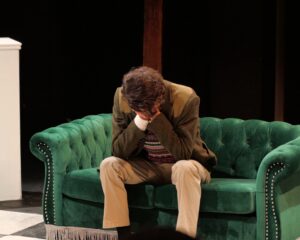On Sept. 20, the University of Maine’s Innovative Media Research and Commercialization (IMRC) hosted a long awaited presentation from visual artist Dave Mackenize. Originally scheduled for March of 2020, the presenter and attendees had to wait another 30 minutes due to a technology issue before Mackenzie could share the purpose behind his subtle, everyday performances. By 7:30pm, Mackenzie was finally able to share with the students and faculty of UMaine’s new media field how he leaves his artistic mark on the world.
The technical difficulty led Mackenzie to talk about the strangeness of life. His style of art relies on the mark he makes on the viewer. He got this idea looking at a stain that was left on a train seat after he rested his head on it. He felt embarrassed and ashamed of his body leaving this mark, but after some thought he found that he could create a series of art pieces or performances that embrace discomfort and shame that we get from our bodies. He wants to combat these feelings by expressing them through art.
“You very clearly see making a mark,” Mackenzie said.
Mackenzie is originally from Kingston, Jamaica. He studied at the Skowhegan School of Painting and Sculpture in Somerset County. He then got his bachelor’s in printmaking from the University of Pennsylvania. He is now based out of Brooklyn, New York and has been making art since 2000.
Mackenzie uses different mediums of art to create a reaction that gets people aware of themselves and their surroundings. He uses public performances, like creating a fake wedding proposal from a plane advertisement or dressing up like Bill Clinton in Harlem, to get his authentic reactions. He particularly forces his audience to pay attention to race and class, even if they don’t want to be aware of it.
“[I] find performance to be the most difficult thing to make,” Mackenzie said.
One particular performance that he began his presentation with was called “Windows.” He noticed how every so often the New York Post magazine would republish covers of poor individuals squeegeeing car windows. It comments on the current economic state of the city, how people are becoming so desperate that they will perform these acts for money. Mackenzie saw this as something many people don’t want to see. He then took this idea and brought it to the Whitney Museum. He created a methodical performance that involved him “washing the windows” with a milky substance that blocked people’s view. He noticed how people were looking outside the window rather than what was on display inside.
“The thing you want to see is being disrupted by a squeegee,” Mackenzie said.
His performance of “Windows” lasted for hours. If someone was looking out the window where he was squeegeeing he moved the squeegee aggressively in front of their faces. Mackenzie was interested in the awkwardness it created. He liked the mixed set of relationships it created in the museum. There were people who had no clue what he was doing and some who ignored him; this was his ideal crowd. There were some people in the museum who knew what he was doing and the performance didn’t have the same effect. After he was done, a crew came by and power washed the windows.
“These things aren’t meant to sit comfortably,” Mackenzie said.
Mackenzie also shared a series of details that New York City cops look out for when they’re assessing if a person is a threat. Many of them were directed toward African Americans. He then performed these actions in a museum.
“I cannot turn this performance off,” Mackenzie said.“It happens outside of the place whether I am there or not.”
In a piece that Mackenzie did in 2002 titled “Self-Portrait Piñata” he made himself into a piñata. The piñata got a place in a museum that, at the time, had a group of children touring through it. They treated the piñata as any other piñata — they hit it with a stick in order to get the candy inside. The children were oblivious to the fact that they were breaking open an African-American shaped piñata that Mackenize felt represented lynchings. He did not go into much detail about the piece after that fact; the room was stunned.
“As a person of color, these are many actions and behaviors that represent a power imbalance,” Mackenzie said.
By the end of the presentation, these subtle performances were successful in showing us things we did not want to see.
The Innovative Media Research and Commercialization hosts a series of visiting artist lectures on Tuesdays at 7 p.m. The events are open to the public. Next week’s visiting artist will be Tectonic Industries.
For more information, check out the IMRC’s website.









